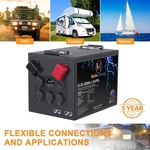I know this is Ozbargain and someone may say that they can buy a 12V 200Ah LiFePO4 for less. And that's absolutely correct. However that battery WILL NOT have a Smart 250A Daly BMS with Bluetooth, it also won't be using Lishen cells or have any of the other benefits our battery has. In fact, it won't specify what components it uses and they will be of inferior quality.
So please have a look at the listing below, as the designer, I'm more than happy to answer any questions that you may have!
The list price is $1,297, however using "OZBARGAIN" will get you an extra $20 off.
Perfect for your 4WD, caravan, camper van or boat!
This 12V 200Ah (190Ah+ usable) drop in lead-acid-replacement battery has been made with ease of connectivity in mind. Whether your device uses USB A, USB C, cigarette lighter socket, 50A Anderson connector or ring terminals, this battery has got you covered. Further, the USB C has PD up to 45W and 20V, meaning that you can charge laptops and iPads with this charger.
It also features a stainless steel case and a 5A active cell balancer to ensure this battery will continue to do its job for many years to come.
The 250A Daly BMS with Bluetooth makes it very easy to check and set parameters of your battery to ensure it’s perfectly customised to your needs.
The quality Lishen cells that are used in the battery and the 5A active balancer mean that you will enjoy these batteries for many years to come.
Backed by our Australian 5 year warranty
Specifications
12V 200Ah (190Ah+ usable)
Lishen cells
250A Daly Smart BMS with Bluetooth
3x cigarette lighter sockets
1x 45W USB C charger that can charge laptops (PD to 20V)
1x 18W USB A
2x 50A Anderson connectors
5A active balancer
Stainless steel case
5 year warranty
If you have any questions, please feel free to ask here, or in our Facebook group where we discuss all things lithium batteries:
https://www.facebook.com/groups/australianlithiumbatteries/?…


Are we saving $20 or $220?